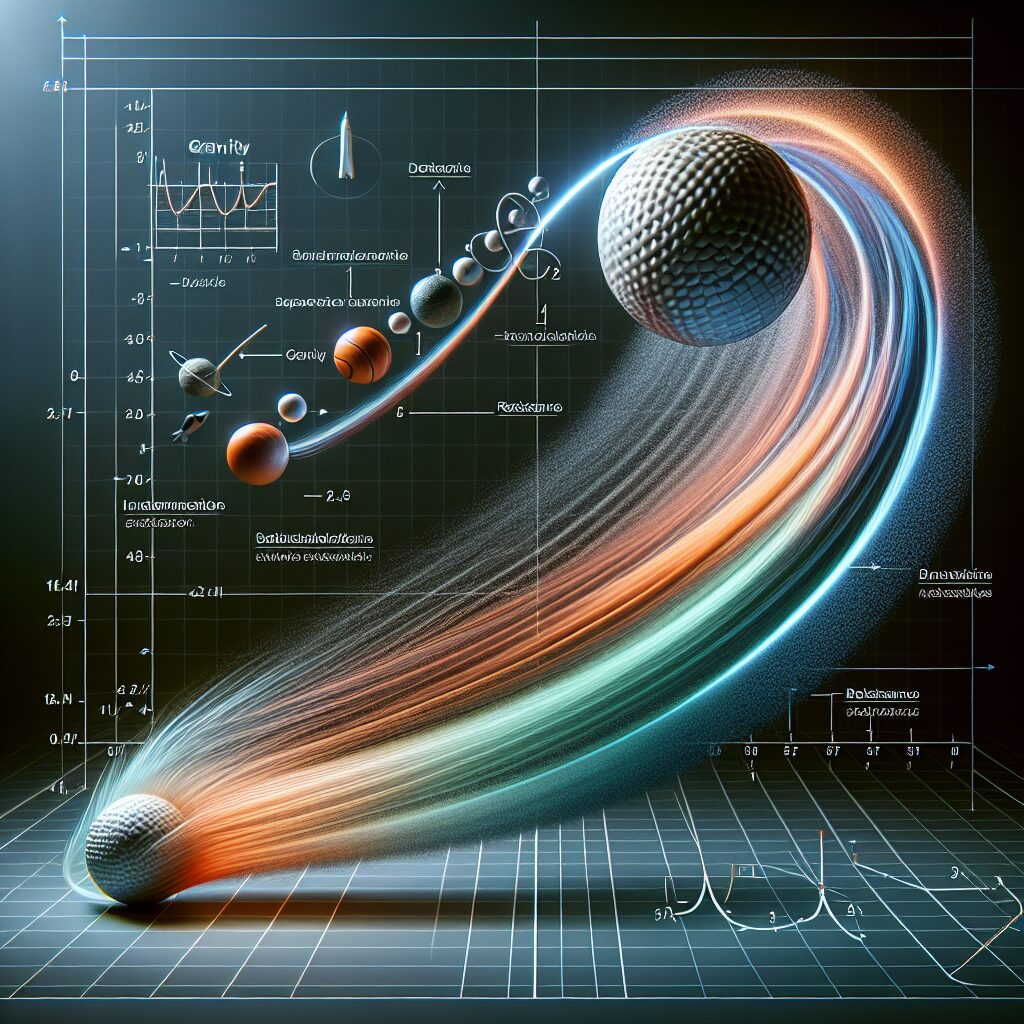Predicting Trajectories: The Science of Ball Dynamics
In the realm of sports, predicting the trajectory of a ball is crucial for both players and spectators alike. Whether it’s a golf ball soaring through the air, a soccer ball swerving past defenders, or a basketball arcing towards the hoop, understanding the science behind ball dynamics can unlock a world of strategic possibilities. At its core, the concept of ball dynamics refers to the study of how a ball’s speed, spin, and angle of launch affect its path through space. By unraveling the intricate interplay between these factors, researchers and athletes can gain valuable insights into predicting and controlling the movement of balls with remarkable precision.
Understanding the intricacies of ball dynamics has far-reaching impacts in various sports and industries. In tennis, for example, players rely on their understanding of ball trajectories to execute powerful serves and precisely aimed shots. By leveraging the principles of ball dynamics, they can strategize their moves, capitalizing on the advantageous angles that can be achieved. Similarly, in the field of engineering, knowledge of how balls behave when launched or propelled can inform the design and optimization of a wide range of mechanical systems, such as catapults or projectile launchers.
In the upcoming sections, we will delve deeper into the fascinating world of ball dynamics by exploring key principles and concepts. We will examine the effect of different forces and factors on ball trajectories, such as gravity, air resistance, and spin. Additionally, we will discuss the role of advanced technologies, like motion tracking systems and computer simulations, in predicting and analyzing ball movements. By the end of this article, you will have a solid understanding of the science behind the mesmerizing flight paths of balls in various sports and how this knowledge can have practical applications in different domains. So, let’s embark on this captivating journey into the realm of predicting trajectories and uncover the secrets behind the movements of our favorite balls.
Key Takeaways
1. Factors Affecting Ball Trajectory: Ball trajectories are influenced by a combination of initial launch conditions and external forces such as gravity, air resistance, and spin. Understanding these factors is crucial in accurately predicting the ball’s path.
2. Launch Angle and Velocity: The launch angle and velocity greatly impact the trajectory of a ball. A higher launch angle creates a steeper ascent and descent, while increased launch velocity leads to longer flight distances and higher peaks.
3. Spin and Its Effects: Spinning the ball can result in significant changes to its trajectory. Backspin generates lift, causing the ball to stay in the air longer and creating a shallower descent. Conversely, topspin brings the ball down faster and causes it to bounce higher.
4. Air Resistance: The presence of air resistance affects the path of the ball, causing it to deviate from the ideal parabolic trajectory. Depending on the ball’s speed and shape, air resistance can have either a minor or major impact on its flight.
5. Physics Modeling and Technological Advances: Advanced mathematical and computer-based models have been developed to analyze and predict ball trajectories with greater accuracy. These models take into account numerous variables simultaneously and have greatly enhanced our understanding of ball dynamics in various sports.
What is the Science Behind Predicting Trajectories: The Science of Ball Dynamics?
1. The Concept of Trajectories and Ball Dynamics
Trajectories and ball dynamics play a crucial role in various fields, such as sports, engineering, and physics. Understanding how a ball moves through the air or on different surfaces is essential for predicting its trajectory accurately. This section delves into the fundamentals of trajectories and ball dynamics.
The Role of Air Resistance
Air resistance, also known as drag, affects the trajectory of a ball. Exploring the principles of air resistance helps in comprehending the science behind predicting ball trajectories. Factors such as ball shape, surface area, and velocity are essential elements in determining the impact of air resistance on the ball’s path.
The Influence of Spin
Spin is another critical factor in predicting ball trajectories. Whether it’s backspin, topspin, or sidespin, the rotation of the ball affects its movement through the air. This section explores the relationship between spin and trajectory, highlighting how different types of spin impact the path the ball takes.
Surface Effects on Ball Dynamics
The type of surface on which a ball is moving significantly affects its trajectory. Whether it’s grass, concrete, or a hardwood floor, each surface introduces different frictional forces and impacts the ball’s behavior. Understanding surface effects is vital for accurate trajectory prediction.
2. Mathematical Models for Trajectory Prediction
Predicting ball trajectories involves mathematical models and calculations. This section delves into the various models and equations employed to forecast how a ball will move through the air or bounce off different surfaces.
Projectile Motion Equations
Projectile motion equations form the foundation for predicting the trajectory of a ball in free flight. These equations consider initial velocity, launch angle, and gravitational force to determine the ball’s path. Exploring these equations helps in understanding how to calculate and predict ball trajectories accurately.
Complex Dynamics Models
For more advanced simulations, complex dynamics models come into play. These models take into account additional factors like air density, temperature, and the ball’s physical properties. By incorporating more variables, these models offer higher precision in predicting trajectories.
3. Application of Predicting Trajectories: Real-World Examples
Predicting trajectories has practical applications in various fields. This section explores how the science of ball dynamics enables experts to forecast and analyze ball movements in real-world scenarios.
Sports Performance Enhancement
In sports like baseball, golf, or tennis, predicting ball trajectories is crucial for athletes and coaches. Understanding how a ball will react after impact allows players to make more informed decisions and improve their performance. This section highlights how the science of ball dynamics contributes to sports training and strategy.
Designing Projectile Systems
Engineers and designers often require accurate trajectory predictions when developing systems that involve projectiles, such as missiles or rockets. By applying the principles of ball dynamics, designers can optimize the performance and efficiency of their projectile systems.
Ballistics and Forensics
In forensic investigations or ballistics analysis, predicting the trajectory of a bullet or a projectile is crucial for reconstructing events and gathering evidence. By utilizing the science of ball dynamics, experts can determine the path a projectile followed, aiding in investigations and crime scene analysis.
4. Tips for Improving Trajectory Prediction Accuracy
Here are some practical tips to enhance the accuracy of predicting ball trajectories:
- Consider the effects of air resistance on the ball’s path.
- Take into account the type and amount of spin on the ball.
- Analyze the impact of the surface on which the ball is moving.
- Use projectile motion equations and complex dynamics models for precise predictions.
- Collect accurate initial conditions, including velocity, launch angle, and physical properties of the ball.
Frequently Asked Questions
How can ball dynamics be predicted?
Ball dynamics can be predicted by considering factors such as initial velocity, launch angle, air resistance, and gravity. Mathematical models and computer simulations are commonly used to calculate and predict ball trajectories.
What role does air resistance play in predicting ball trajectories?
Air resistance, also known as drag, is a crucial factor in predicting ball trajectories. As a ball moves through the air, it experiences resistance due to the molecules in the air colliding with its surface. The magnitude of air resistance depends on the ball’s shape, size, and velocity. Considering air resistance allows for more accurate predictions of ball trajectories.
How does initial velocity affect ball trajectories?
Initial velocity, which refers to the speed at which a ball is launched, greatly affects its trajectory. The higher the initial velocity, the longer the ball will stay in the air and the farther it will travel horizontally. Additionally, the angle at which the ball is launched in combination with the initial velocity determines the trajectory’s shape.
What role does gravity play in predicting ball trajectories?
Gravity plays a significant role in predicting ball trajectories. It acts as a force that pulls the ball downward, causing it to follow a curved path. The magnitude of the gravitational force remains constant, leading to predictable trajectories when combined with other factors such as initial velocity and launch angle.
Are ball dynamics predictable in all scenarios?
Ball dynamics are predictable to a certain extent, but there are limitations. Factors such as wind, spin, and irregular surfaces can introduce uncertainties into the predictions. However, by considering known variables and employing accurate mathematical models, it is possible to make reasonably accurate predictions for most scenarios.
Can ball dynamics prediction be applied to different sports?
Yes, the science of predicting ball dynamics can be applied to various sports. Whether it’s baseball, basketball, golf, soccer, or tennis, understanding the principles of ball dynamics allows coaches, players, and scientists to analyze and optimize performance. Each sport may have its specific variables, but the fundamentals of predicting ball trajectories remain applicable.
How is the science of ball dynamics used in sports training?
The science of ball dynamics plays a crucial role in sports training. By analyzing and predicting ball trajectories, coaches can identify areas for improvement, develop training drills, and fine-tune technique. Understanding the science behind ball dynamics helps athletes optimize their performance and make strategic decisions during gameplay.
Are there any real-world applications of predicting ball trajectories?
Absolutely! Predicting ball trajectories finds applications in a variety of fields. In engineering, it aids in designing projectiles, ballistics, and even automobile safety systems. In the entertainment industry, it helps animators create realistic motion in movies and video games. Additionally, it plays a significant role in robotics, virtual reality simulations, and the design of sports equipment.
What are the limitations of predicting ball trajectories?
While predicting ball trajectories is a valuable tool, it is not without limitations. Factors such as wind, spin, and unpredictable ball-to-surface interactions can introduce uncertainties. Additionally, the accuracy of predictions heavily relies on the quality of measurements and assumptions made in mathematical models. Nonetheless, advancements in technology and computational power continue to improve the accuracy and precision of predictions.
How can understanding ball dynamics benefit players and teams?
Understanding ball dynamics provides players and teams with a competitive advantage. By recognizing how factors like velocity, launch angle, and air resistance influence trajectories, athletes can improve their performance and make more accurate decisions on the field. Furthermore, teams can use this knowledge to strategize game plans, analyze opponents’ strengths and weaknesses, and enhance overall gameplay.
Final Thoughts
Predicting trajectories is an intricate science that combines physics, mathematics, and technological advancements. The ability to accurately forecast ball dynamics has wide-ranging applications, from sports training and performance optimization to engineering and entertainment. It is fascinating to see how a deep understanding of the principles governing ball movements can enhance our capabilities in various fields.
As our knowledge and tools continue to advance, we can expect even more precise predictions and applications of ball dynamics. The ongoing exploration of new materials, improved sensors, and sophisticated algorithms will further deepen our understanding and enable us to unlock new possibilities in predicting and manipulating ball trajectories. Embracing this science can contribute to advancements in multiple domains and enhance our overall understanding of the physical world around us.




